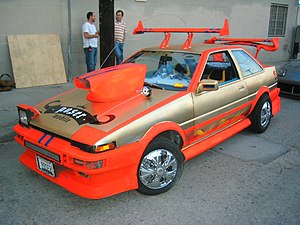
Drag racing is a type of motor racing in which automobiles or motorcycles compete, usually two at a time, to be first to cross a set finish line. The race follows a short, straight course from a standing start over a measured distance, most commonly 1⁄4 mi, with a shorter, 1,000 ft distance becoming increasingly popular, as it has become the standard for Top Fuel dragsters and Funny Cars, where some major bracket races and other sanctioning bodies have adopted it as the standard. The 1⁄8 mi is also popular in some circles. Electronic timing and speed sensing systems have been used to record race results since the 1960s.
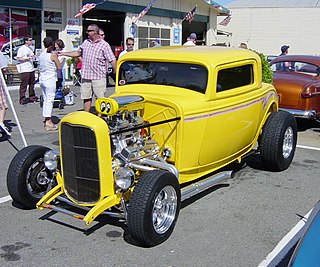
Hot rods are typically American cars that might be old, classic, or modern and that have been rebuilt or modified with large engines optimised for speed and acceleration. One definition is: "a car that's been stripped down, souped up and made to go much faster." However, there is no definition of the term that is universally accepted and the term is attached to a wide range of vehicles. Most often they are individually designed and constructed using components from many makes of old or new cars, and are most prevalent in the United States and Canada. Many are intended for exhibition rather than for racing or everyday driving.
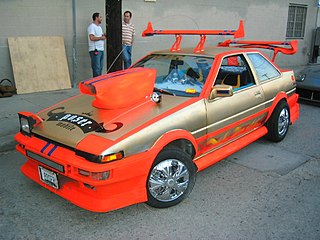
Rice burner is a pejorative term originally applied to Japanese motorcycles and which later expanded to include Japanese cars or any East Asian-made vehicles. Variations include rice rocket, referring most often to Japanese superbikes, rice machine, rice grinder or simply ricer.

Nissan Motorsports International, abbreviated as Nismo, is a division of Nissan Motorsports & Customizing focused in motorsport and performance-oriented car models for Nissan. Nismo was initially a company, Nissan Motorsports International Co., Ltd., formed in 1984 as a result of a merger of two motorsport departments, being the in-house tuning, motorsports and performance subsidiary of Nissan. It has competed in JSPC, JTCC, the 24 Hours of Le Mans and the 24 Hours of Daytona. They currently participate in Super GT, GT Racing and Formula E. Nismo ceased to be a company in April 2022 by being merged with sister Autech into a new Nissan subsidiary, Nissan Motorsport & Customizing.
Grey import vehicles are new or used motor vehicles and motorcycles legally imported from another country through channels other than the maker's official distribution system. The synonymous term parallel import is sometimes substituted.

Car tuning is the modification of a car to optimise it for a different set of performance requirements from those it was originally designed to meet. Most commonly this is higher engine performance and dynamic handling characteristics but cars may also be altered to provide better fuel economy, or smoother response. The goal when tuning is the improvement of a vehicle's overall performance in response to the user's needs. Often, tuning is done at the expense of emissions performance, component reliability and occupant comfort.

Bōsōzoku is a Japanese youth subculture associated with customized motorcycles. The first appearance of these types of biker gangs was in the 1950s. Popularity climbed throughout the 1980s and 1990s, peaking at an estimated 42,510 members in 1982. Their numbers dropped dramatically in the 2000s, with fewer than 7,297 members in 2012.

The import scene, also known as the import racing scene or tuner scene, is a subculture of modifying mostly Japanese-import cars, particularly in the United States and Europe.

Drifting is a driving technique where the driver intentionally oversteers, with loss of traction, while maintaining control and driving the car through the entirety of a corner. The technique causes the rear slip angle to exceed the front slip angle to such an extent that often the front wheels are pointing in the opposite direction to the turn. Drifting is traditionally done by clutch kicking, then intentionally oversteering and countersteering. This sense of drift is not to be confused with the four wheel drift, a classic cornering technique established in Grand Prix and sports car racing.
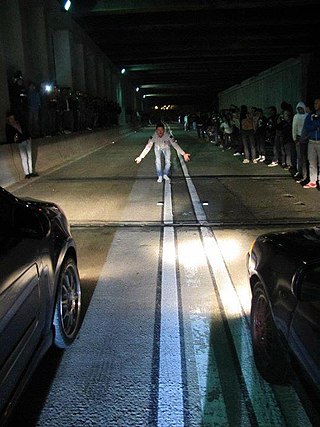
Street racing is typically an unsanctioned and illegal form of auto racing that occurs on a public road. Racing in the streets is considered an ancient hazard, as horse racing occurred on streets for centuries, and street racing in automobiles is likely as old as the automobile itself. It became especially prevalent during the heyday of hot rodding (1960s), muscle cars (1970s), Japanese imports (1990s) and sports cars (2000s). Since then, it continues to be both popular and hazardous, with deaths of bystanders, passengers, and drivers occurring every year. In the United States, modern street racing traces its roots back to Woodward Avenue, Michigan, in the 1960s when the three main Detroit-based American car companies were producing high-powered performance cars. Since a private racing venue was not always available, street races would be held illegally on public roads.
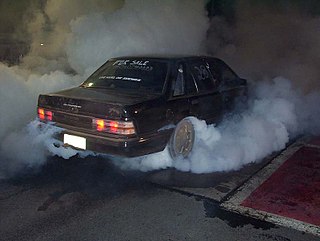
A hoon is an Australian term describing a person who deliberately drives a vehicle in a reckless or dangerous manner, generally in order to provoke a reaction from onlookers.

STILLEN is the automotive aftermarket parts company created by Steve Millen, a former racecar driver for Nissan who was known for racing the 300ZX. In 1986, STILLEN began selling mini-truck ground effects and then began fulfilling orders for vans and full-sized trucks. However, STILLEN became known for specializing in parts for Nissan cars, but also supplies parts for other vehicles such as the Ford GT and Toyota 86. STILLEN also develops parts for other cars such as the Chevrolet Camaro and Ford F150. In 1996, STILLEN purchased a machining shop from Frank Shuter, a former New Zealand speedway champion.
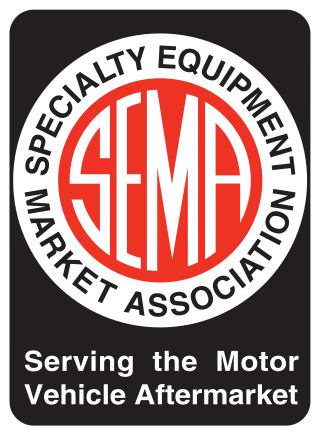
Specialty Equipment Market Association (SEMA) of the automobile aftermarket was formed in 1963 by Roy Richter, Ed Iskenderian, Els Lohn, Willie Garner, Bob Hedman, Robert E. Wyman, John Bartlett, Phil Weiand Jr, Al Segal, Dean Moon, and Vic Edelbrock Jr. and now consists of 6,383 companies worldwide, bringing together aftermarket manufacturers, original equipment manufacturers (OEM), media, car dealers, specialty equipment distributors, installers, retailers and restoration specialists.

A body kit or bodykit is a set of modified body parts or additional components that install on a stock car. Typically composed of front and rear bumpers, side skirts, spoilers, bonnets, and sometimes front and rear side guards and roof scoops. There are many companies that offer alternatives to the original factory appearance of the vehicle. Body kit components are designed to complement each other and work together as a complete design. Despite this, the 'mix and match' approach is often seen on cars, where the front of one body kit will be matched with the rear of another, for example.
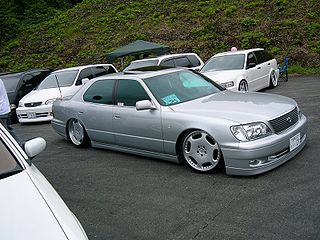
VIP style is a car modification trend that translates from the Romanised Japanese term 'bippu.' It refers to the modification of Japanese luxury automobiles to make them lower and wider in stance, with more aggressive wheels, suspension, and body kits. VIP Style cars are typically large, rear-wheel drive luxury sedans, although automotive enthusiasts sometimes use other cars such as minivans or kei cars.

Steve Millen is a retired New Zealand IMSA race car driver. In the 1970s and 1980s, Millen raced in hillclimbing and Formula Ford before doing stadium off-road racing in the United States in the Mickey Thompson Entertainment Group (MTEG). He then began sports car racing, winning numerous championships in IMSA Camel GT. Millen won 20 races in the series, including the 24 Hours of Daytona and the 12 Hours of Sebring.
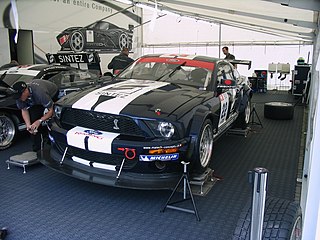
The Ford Racing Mustang FR500 is a highly tuned race variant of the Ford Mustang, featuring a V8 engine. It is a turn key race car not designed for public roads. Each FR500 model is built with a unique Ford Racing number, instead of a DOT VIN. Each is built to order by Ford Racing. All FR500s are made at the same Flat Rock, Michigan plant as the standard Mustang.

The Tokyo Auto Salon is an annual auto show held in January at the Makuhari Messe, Chiba City, Japan for Performance and custom aftermarket parts and technology displays. Hosted by the Nippon Auto Parts Aftermarket Committee (NAPAC), the Tokyo Auto Salon is one of the top motor shows globally for modified and tuned cars. The 2019 Tokyo Auto Salon featured 906 vehicles, 426 exhibitors, and 4,175 booths that offered aftermarket accessories for purchase. There are also after-market parts manufacturers, custom shops, care manufacturers, automotive businesses, and automotive vocational schools. There are not only custom cars and after-market manufacturers, there is also live entertainment. Top musicians from around the world and talk shows hosting famous drivers and celebrities can be seen at the Tokyo Auto Salon.

NZ Performance Car is a monthly automobile magazine and website, and is the biggest selling automotive and men's lifestyle magazine in New Zealand.

The New Zealand Vehicle Confiscation and Seizure Bill was a Government bill introduced to the NZ Parliament on 26 March 2009.
